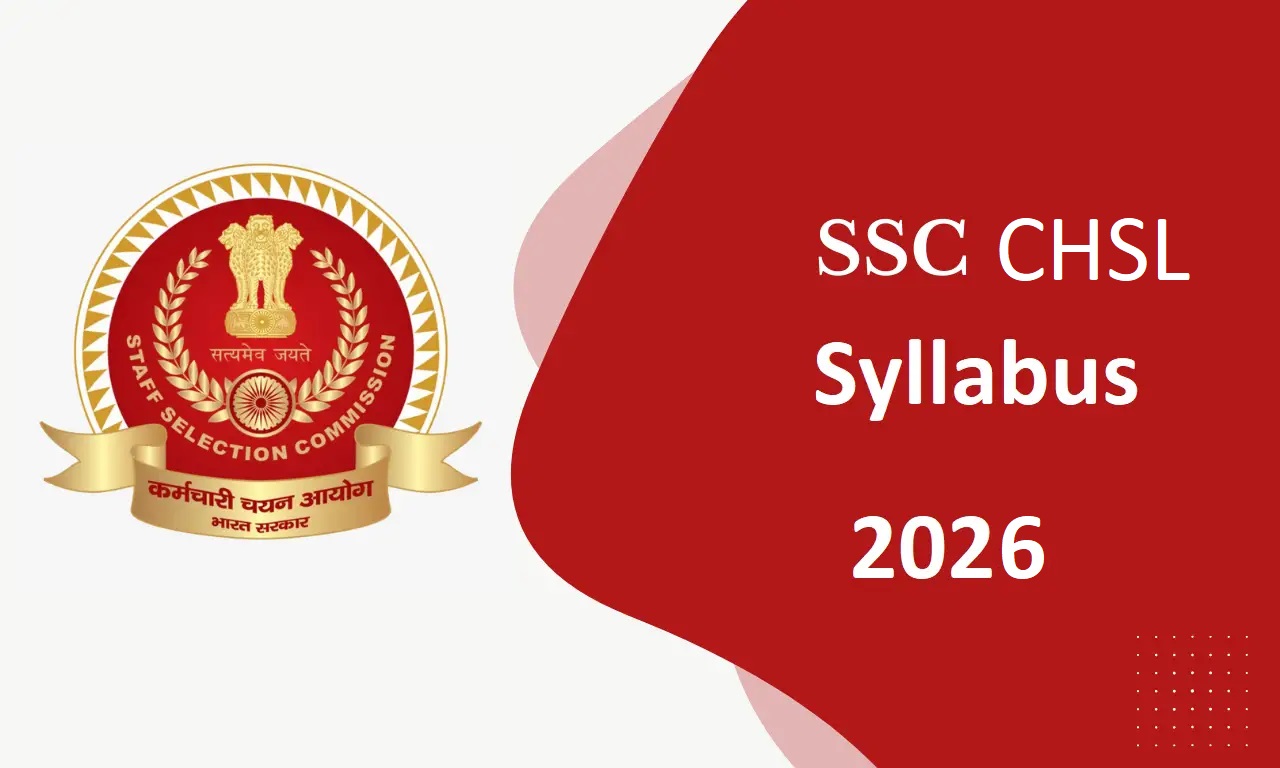The Staff Selection Commission Combined Higher Secondary Level (SSC CHSL) exam is one of the most popular recruitment examinations in India for various government posts such as Lower Division Clerk (LDC), Junior Secretariat Assistant (JSA), Data Entry Operator (DEO), and others. It is conducted annually to fill vacancies in ministries, departments, and organizations under the Government of India. As of now, the official notification for SSC CHSL 2026 has not been released, but based on the pattern from previous years, including 2025, the syllabus is expected to remain largely unchanged unless specific updates are announced by the SSC. This stability allows aspirants to prepare confidently using the current structure.
In this blog post, we’ll dive into the detailed syllabus for SSC CHSL 2026, covering both Tier 1 and Tier 2 exams, along with the exam pattern. We’ll also address common questions in the FAQ section to help you navigate your preparation effectively. Remember, the exam tests your knowledge in English, Reasoning, Quantitative Aptitude, and General Awareness, with an emphasis on speed and accuracy due to negative marking.
SSC CHSL 2026 Exam Pattern Overview
The SSC CHSL exam is conducted in two tiers:
- Tier 1: Objective-type computer-based test (CBT) – Qualifying in nature.
- Tier 2: Objective-type CBT with a skill/typing test – Final merit based on this tier.
Both tiers are online, and candidates must qualify in Tier 1 to appear for Tier 2. Here’s a quick comparison:
| Aspect | Tier 1 | Tier 2 |
|---|---|---|
| Mode | Online CBT | Online CBT + Skill/Typing Test |
| Type | Objective MCQs | Objective MCQs + Practical Test |
| Duration | 60 minutes (80 for PwD) | Session 1: 2 hours 15 minutes; Session 2: 10-15 minutes |
| Total Marks | 200 | 405 (objective) + Qualifying skill test |
| Negative Marking | 0.5 marks per wrong answer | 1 mark per wrong answer (in most sections) |
| Purpose | Screening | Merit determination |
Now, let’s break down the detailed syllabus for each tier.
SSC CHSL Tier 1 Syllabus 2026
Tier 1 is the preliminary stage with four sections, each carrying 25 questions worth 50 marks. The total is 100 questions for 200 marks. Questions are set in English and Hindi (except for the English section). Focus on basic concepts and quick problem-solving.
Exam Pattern for Tier 1
| Section | Questions | Marks | Key Focus Areas |
|---|---|---|---|
| English Language | 25 | 50 | Grammar, Vocabulary, Comprehension |
| General Intelligence | 25 | 50 | Verbal & Non-Verbal Reasoning |
| Quantitative Aptitude | 25 | 50 | Arithmetic, Algebra, Geometry |
| General Awareness | 25 | 50 | Current Affairs, Static GK |
| Total | 100 | 200 | – |
Detailed Topics for Tier 1
- English Language (Basic Knowledge):
- Spot the Error
- Fill in the Blanks
- Synonyms/Homonyms
- Antonyms
- Spellings/Detecting Misspelt Words
- Idioms & Phrases
- One-Word Substitution
- Improvement of Sentences
- Active/Passive Voice of Verbs
- Conversion into Direct/Indirect Narration
- Shuffling of Sentence Parts
- Shuffling of Sentences in a Passage
- Cloze Passage
- Comprehension Passage
- General Intelligence:
- This section includes both verbal and non-verbal questions.
- Semantic Analogy
- Symbolic Operations
- Symbolic/Number Analogy
- Trends
- Figural Analogy
- Space Orientation
- Semantic Classification
- Venn Diagrams
- Symbolic/Number Classification
- Drawing Inferences
- Figural Classification
- Punched Hole/Pattern-Folding & Unfolding
- Semantic Series
- Figural Pattern-Folding and Completion
- Number Series
- Embedded Figures
- Figural Series
- Critical Thinking
- Problem Solving
- Emotional Intelligence
- Word Building
- Social Intelligence
- Coding and Decoding
- Numerical Operations
- Other sub-topics, if any
- Quantitative Aptitude (Basic Arithmetic Skill):
- Number Systems: Computation of Whole Numbers, Decimals and Fractions, Relationship Between Numbers
- Fundamental Arithmetical Operations: Percentages, Ratio and Proportion, Square Roots, Averages, Interest (Simple and Compound), Profit and Loss, Discount, Partnership Business, Mixture and Alligation, Time and Distance, Time and Work
- Algebra: Basic Algebraic Identities of School Algebra, Elementary Surds (Simple Problems), Graphs of Linear Equations
- Geometry: Elementary Geometric Figures and Facts, Triangle and Its Centers, Congruence and Similarity of Triangles, Circle and Its Chords, Tangents, Angles Subtended by Chords, Common Tangents to Two or More Circles
- Mensuration: Triangle, Quadrilaterals, Regular Polygons, Circle, Right Prism, Right Circular Cone, Right Circular Cylinder, Sphere, Hemispheres, Rectangular Parallelepiped, Regular Right Pyramid with Triangular or Square Base
- Trigonometry: Trigonometric Ratios, Complementary Angles, Height and Distances (Simple Problems), Standard Identities like sin²θ + cos²θ = 1
- Statistical Charts: Use of Tables and Graphs – Histogram, Frequency Polygon, Bar-Diagram, Pie-Chart
- General Awareness:
- Designed to test awareness of the environment and its societal applications.
- Current Events
- Everyday Observations and Scientific Aspects
- India and Neighboring Countries: History, Culture, Geography, Economic Scene, General Policy, Scientific Research
- Static GK: Awards and Honors, Books and Authors, Sports, Important Schemes, People in News
SSC CHSL Tier 2 Syllabus 2026
Tier 2 is more comprehensive and determines the final merit. It consists of two sessions on the same day. Session 1 has three sections with modules, while Session 2 is the skill/typing test (qualifying only). Total objective marks: 405.
Exam Pattern for Tier 2
- Session 1 (2 hours 15 minutes): Section/ModuleQuestionsMarksDurationSection 1 – Module 1: Mathematical Abilities3090Rowspan with Module 2: 60 minSection 1 – Module 2: Reasoning & General Intelligence3090Section 2 – Module 1: English Language & Comprehension40120Rowspan with Module 2: 60 minSection 2 – Module 2: General Awareness2060Section 3 – Module 1: Computer Knowledge154515 min
- Session 2 (Qualifying):
- Skill Test for DEO: Data entry speed of 8,000 key depressions per hour (15 min).
- Typing Test for LDC/JSA: 35 wpm in English or 30 wpm in Hindi (10 min).
Negative marking: 1 mark per wrong answer in Sections 1, 2, and Computer Knowledge Module.
Detailed Topics for Tier 2
- Mathematical Abilities (Module 1, Section 1):
- Same as Quantitative Aptitude in Tier 1, with added Statistics and Probability: Measures of Central Tendency (Mean, Median, Mode, Standard Deviation), Simple Probability Calculations.
- Reasoning and General Intelligence (Module 2, Section 1):
- Same as General Intelligence in Tier 1, emphasizing deeper verbal and non-verbal reasoning.
- English Language and Comprehension (Module 1, Section 2):
- Vocabulary, Grammar, Sentence Structure, Synonyms, Antonyms and Correct Usage
- Spot the Error
- Fill in the Blanks
- Synonyms/Homonyms
- Antonyms
- Spellings/Detecting Misspelt Words
- Idioms & Phrases
- One-Word Substitution
- Improvement of Sentences
- Active/Passive Voice
- Direct/Indirect Narration
- Shuffling of Sentence Parts/Sentences
- Cloze Passage
- Comprehension: Two or more paragraphs, including one simple story-based and one on current affairs.
- General Awareness (Module 2, Section 2):
- Same as Tier 1, with a focus on current affairs and scientific research.
- Computer Proficiency (Module 1, Section 3):
- Computer Basics: Organization of a Computer, CPU, Input/Output Devices, Memory, Backup Devices, PORTs, Windows Explorer, Keyboard Shortcuts
- Software: Windows OS, Microsoft Office (Word, Excel, PowerPoint)
- Internet and E-mails: Web Browsing, Searching, Downloading/Uploading, Managing E-mail Accounts, E-Banking
- Networking and Cyber Security: Networking Devices/Protocols, Security Threats (Hacking, Viruses, Worms, Trojans), Preventive Measures
- Skill Test/Typing Test (Module 2, Section 3):
- Qualifying; errors allowed as per guidelines. For DEO in certain departments, higher speed requirements apply.
FAQs on SSC CHSL Syllabus 2026
Here are some frequently asked questions to clarify doubts:
- What is the difference between Tier 1 and Tier 2 syllabus? Tier 1 focuses on basic knowledge across four subjects for screening. Tier 2 is more in-depth, with higher weightage on English and Maths, plus Computer Proficiency and a skill test for final selection.
- Is the syllabus for 2026 different from 2025? As of now, no changes have been announced. The syllabus is expected to be identical, but always check the official SSC notification once released for any updates.
- Is there negative marking in SSC CHSL? Yes, Tier 1 has 0.5 marks deduction per wrong answer, while Tier 2 has 1 mark deduction in objective sections.
- How many questions are there in Tier 2? Session 1 has 135 objective questions (405 marks), plus a 15-question Computer Knowledge test. Session 2 is a practical skill/typing test.
- What is the qualifying criteria for the skill test? It’s qualifying only. For typing, aim for 35 wpm (English) or 30 wpm (Hindi). DEO roles require accurate data entry at specified speeds.
- Can I choose the language for the exam? Yes, except for English Language sections, questions are bilingual (English/Hindi). Skill tests allow choice of medium.
- How should I prepare for General Awareness? Focus on current affairs (last 6-12 months), static GK like history and geography, and read newspapers daily. Use apps or yearbooks for quick revisions.
- Are there any relaxations for PwD candidates? Yes, extra time (20 minutes in Tier 1), and exemptions from certain components like graphs in reasoning/math for visually impaired candidates.
- What posts are filled through SSC CHSL? Mainly LDC, JSA, DEO, and Sorting Assistant in various government offices.
- When will the SSC CHSL 2026 notification be released? Typically in the first half of 2026, but monitor the official SSC website for exact dates.
Preparing for SSC CHSL requires consistent practice, mock tests, and time management. Start with understanding the basics, then move to advanced topics. Good luck with your preparation! If you have more questions, drop them in the comments.

Hi, I’m Varun Pathak, the founder of TheSarkariNaukri.com—a dedicated platform for the latest updates on government jobs (Sarkari Naukri) in India. With years of experience curating reliable information on job vacancies, admit cards, exam results, and preparation strategies, I help thousands of aspirants navigate the competitive world of public sector opportunities. Passionate about job security, career growth, and empowering freshers for roles like IAS, IPS, and PSU positions, I update the site regularly with actionable insights for 2025 and beyond. Let’s connect to turn your career dreams into reality!
